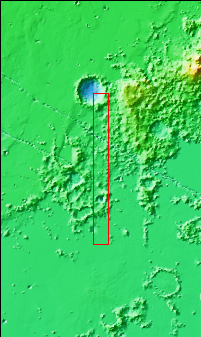
|
Cerberus Fossae
- Click the image above for a larger view
- Full-Res JPEG (613 x 2703) (93.0 kB)
- Full-Res TIFF (613 x 2703) (785.3 kB)
Caption:

Context image
The linear depressions in today's VIS image are part of Cerberus Fossae. The features are termed grabens, and are formed by extensional tectonic forces. As the regional fractures move apart, blocks of material subside between paired faults. The straight sides and uniform depths are indications that this is tectonic feature rather than a channel caused by fluid erosion. The fossae stretch for 1235km (767 miles).
Orbit Number: 85522 Latitude: 9.58809 Longitude: 159.803 Instrument: VIS Captured: 2021-03-26 04:37
Background Info:
Please see the THEMIS Data Citation Note for details on crediting THEMIS images.
NASA's Jet Propulsion Laboratory manages the 2001 Mars Odyssey mission for NASA's Science Mission Directorate, Washington, D.C. The Thermal Emission Imaging System (THEMIS) was developed by Arizona State University, Tempe, in collaboration with Raytheon Santa Barbara Remote Sensing. The THEMIS investigation is led by Dr. Philip Christensen at Arizona State University. Lockheed Martin Astronautics, Denver, is the prime contractor for the Odyssey project, and developed and built the orbiter. Mission operations are conducted jointly from Lockheed Martin and from JPL, a division of the California Institute of Technology in Pasadena.
Cataloging Keywords:
| Name | Value | Additional Values |
|---|---|---|
| Target | Mars | |
| System | ||
| Target Type | Planet | |
| Mission | 2001 Mars Odyssey | |
| Instrument Host | Mars Odyssey | |
| Host Type | Orbiter | |
| Instrument | Thermal Emission Imaging System (THEMIS) | |
| Detector | ||
| Extra Keywords | Grayscale, Thermal | |
| Acquisition Date | ||
| Release Date | 2021-08-18 | |
| Date in Caption | 2021-03-26 | |
| Image Credit | NASA/JPL-Caltech/ASU | |
| Source | photojournal.jpl.nasa.gov/catalog/PIA24828 | |
| Identifier | PIA24828 | |
